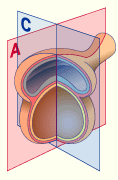|
In order to understand how this turning takes place, the structures must first be described that are found in the cephalic end before the folding:
In the cephalic region, rostral to the prechordal plate and the pharyngeal membrane, the mesenchymal cells form the cardiac plate (pericardium) and the septum transversum (which later becomes a part of the diaphragm and separates the coelom into thoracic and abdominal cavities).
With the 180° degree turn that results from the folding, the following occurs:
the pharyngeal membrane extends towards the lower front (mouth area) and the cardiogenic plate (which initially lay most cranially) into the thorax area. Between the cardiac anlage and the umbilical vesicle a mesenchymal bridge forms, the septum transversum.
After this movement is completed, the brain (encephalon) lies the most cranially, followed by the mouth, heart, and diaphragm (septum transversum). During this folding the endoderm below the pharyngeal membrane becomes surrounded ventrally by the cardiac anlage. From this region, the throat (pharynx) arises and, subsequently, the thyroid gland, the lungs, and the esophagus. The pharyngeal membrane that for now separates the mouth (ectoderm) from the throat (endoderm) later atrophies  13 13 . .
|
|
|
What ?
How ? Where ?
|
|
- Cephalo-caudal flexion takes place in the A plane
- Lateral folding takes place in the C plane
|
 |
|

